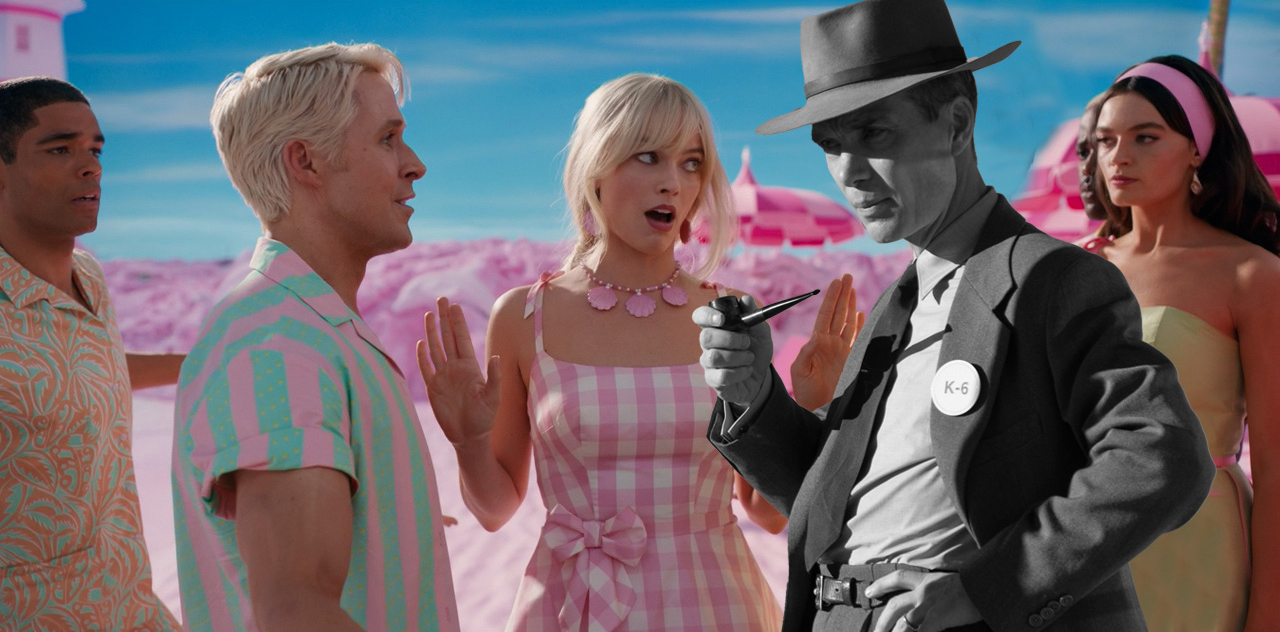Movies

New Releases • A-D • E-H • I-P • Q-Z • Articles • Festivals • Interviews • Dark Knight • Indiana Jones • MCU

Barbie photo and other imagery courtesy of Warner Bros.; Oppenheimer photo and poster courtesy of Universal Pictures.
Barbenheimer mash-up image and posters created by MAD (The Matthew Anderson Designery).
Barbenheimer: Movieland D-Day
21 July 2023
#Oppenheimer • #BarbieMovie
21 July 2023. It’s a day that will live in movie infamy.
The COVID Cohort
A lot has been made of Barbenheimer, the incongruous release of two high-profile movies on the same day. One’s about a toy doll, the PG-13 Barbie, and the other’s about the Father of the Atomic Bomb, the R-rated Oppenheimer. It’s been reported tens of thousands purchased advance tickets for both movies, creating an unlikely double-feature no programmer would’ve been brave enough to attempt.
But there’s a story behind all this, at least a conspiracy theory bouncing around in my head.
It all ties back to the release of Tenet. With COVID running rampant around the world, theatres closed. Movie release dates were pushed out. At the extreme end, the final Daniel Craig James Bond adventure, No Time to Die, was pushed out three times and was delayed a whopping total of 18 months.
Tenet was supposed to be released in July 2020. Somehow, Nolan was able to advocate for theatres to start reopening in late August 2020 and Tenet became the first major release during the pandemic era. As a soft opening ahead of Tenet, some theatres offered discount tickets to an IMAX re-release of Inception (so good to see that again in IMAX).
But Warner Bros. was crafting a strategy that didn’t sit well with many, including theatre owners. Movies would start to be released in theatres and on HBO Max on the same day. Tenet would be an exception to that strategy. It received a release exclusively in theatres.
This devaluation of the theatrical experience led to Nolan packing up Syncopy and walking away from the studio he enriched for 15 years.
Cinema Cannibals
Warner Bros. and other studios, including Disney, have entered an age of cannibalization. In technology, the concept revolves around launching a new product that might take away market share from a different product in the portfolio. For example, when Apple launched the iPad, there were concerns about the impact it would have on iPhone or MacBook sales.

In the theatrical space, there is now a ridiculously short window to see major movies in the “premium” formats. Most enjoy only one weekend in an IMAX theatre, maybe 10 or 12 days maximum, before the next big release comes along and takes that space. Back in 2005, Batman Begins enjoyed a healthy IMAX run through the whole summer and was even held-over for split-screen, late-night showings.
Exhibitors benefit from longer theatrical runs; they pass less in rentals to the studios the longer a movie plays. On the flip side, studios see cost savings from marketing expenses by piggybacking streaming and physical home media platforms onto the theatrical release through shorter windows.
The end result? Movies essentially have a shorter shelf life before being relegated into a catalog of content.
“Content” is a demeaning way of categorizing movies (or film or motion pictures, take your pick) to feed the streaming beast. Top directors, including Martin Scorsese, have taken umbrage with the term. Come to think of it, Scorsese also used to be a part of the Warner movie family but, ironically, his recent work has been released by surprising partners. The Irishman was released by Netflix and the upcoming Killers of the Flower Moon is coming from Apple.
Now, give it 45 days and most movies are available to stream at home. Without the expensive tickets, concessions and social misfits on their phones.
The window keeps shrinking. The Flash, originally pegged as a summer blockbuster with its pairing of both Michael Keaton and Ben Affleck as Batman, took a nosedive and within five weeks it was already available for streaming rentals. Some of the poor performance is backlash for star Ezra Miller’s controversial off-screen conduct; part of it is retribution for Warner cancelling a Batgirl movie. And, no doubt, Snyder’s army of rabid fans — those who undermined the Oscar’s ill-conceived “fan favorite” voting — had something to do with.
A Conspiracy Theory
Here’s the conspiracy theory: Nolan took Syncopy to Universal, which has released Oppenheimer. I can’t help but think Warner Bros. was making a figurative poke in the eye by releasing Barbie on the same date. A demonstration they’re still in the theatrical game and willing to spend on a big marketing push. A distraction from the monumental accomplishment of Oppenheimer, while also undermining Greta Gerwig’s own milestone accomplishment with Barbie.
Based on what I’ve pieced together, Universal announced Oppenheimer’s 21 July 2023, release date in October 2021. Warner Bros. announced Barbie’s 21 July 2023, release date in April 2022.
Historically, Nolan has frequently selected release dates in mid- to late-July. Among them, Dunkirk was released on 21 July 2017 and The Dark Knight Rises on 20 July 2012.
It’s a conspicuous choice by Warner Bros., but summer is a densely packed movie season. Maybe it was nothing; maybe there’s nothing to see here, so to speak.
Or maybe not.
Regardless, an argument could be made both movies would have been better served with separate release dates. Both are culturally significant: Oppenheimer as an overwhelming look at a significant time in American history; Barbie as the most financially successful launch of a female-directed movie in Hollywood history. Both deserved at least one weekend all its own. Barbenheimer created a lot of buzz and brought a lot of eyes back to the movies, but the long-term cost might not be worth it given the incredible shrinking streaming window.
Perhaps the most offensive part of the Barbenheimer weekend is it took two movies ultimately intended for two completely different audiences seeking totally different experiences and set them against each other. Artistically, it’s offensive. Commercially, it creates a mere blip of attention.
One is a serious historical look at male-dominated power structures (with an open acknowledgement of strong women in the political trenches) and the end of a world war which swung in the right direction, the direction which paved the way allowing for the Barbie toyline to exist. That one uses black-and-photography and large-format IMAX film to make an experience and evoke an emotional response. The other is a satire poking at patriarchy and sexism, presented in eye-popping full color. The two movies could not be more diametrically opposed thematically, and that’s where Barbenheimer ultimately debases both. This should not be a conversation about which movie is “better.” That’s a fool’s argument perfectly suited for social media.
The Fallout
Early box office reports indicate maybe everybody wins this time. Tallies look toward Barbie pulling in $155 million with Oppenheimer racking up $80 million. That’s in North America alone. Both are an easy double of the initial weekend projections. Both broke records individually. Barbie had a record-breaking weekend for a female-directed movie. Oppenheimer broke the record for an R-rated movie. Plus, its 3-hour run-time would typically reduce the number of showtimes.
Nonetheless, it’s an exceptional weekend in a year which has seen the box office stumble in its post-pandemic recovery. Before Christmas — maybe even before Halloween — both movies will be readily available on streaming services. The value proposition of the theatrical experience will continue to be a point of contention.
Much like a theme running through Oppenheimer, in the end nobody will really win the theatrical war. With budgets outpacing box office receipts, Disney’s Bob Iger has stated the Mouse House will scale back budgets and the number of productions. Certainly not a winning scenario for audiences, but it will likely only fuel the box office decline going forward, as those small-scale productions will be enjoyed at home within a matter of weeks after their theatrical release.
That’s all part of the short-sighted nature of the business right now.
More Fallout
20 August: It was announced this past week Barbie surpassed Nolan’s Dark Knight box office tally to become Warner Bros.’ top-grossing movie in North America. Of course, that’s following the old Hollywood trick of ignoring inflation. In 2008, The Dark Knight grossed $536 in North America ($1 billion globally). Accounting for 15 years of inflation and using today’s dollar value, that puts Dark Knight at $761.12 million in North America and $1.42 billion globally. Stunning amounts.
Nonetheless, with more than $600 million in the bank worldwide, Oppenheimer has exceeded expectations as well. It’s also worth putting its success in the context of Nolan having made the three-hour epic on a relatively modest $100 million budget, even with the vast majority of the movie being shot on location. (I’ll take on-location filming over ILM’s StageCraft Volume every single time.)





